Common Misconceptions with Squatting – part 1
We often hear contradictory squat rules echoed throughout gyms and health clubs – some emerged through research while others lie in myth. Furthermore, watching fitness professionals squat demonstrates how often they are incapable of squatting correctly due to inadequate levels of mobility or stability (e.g., ankle mobility). So, let’s examine some common misunderstandings:
- Told to Keep our Knees Behind our Toes
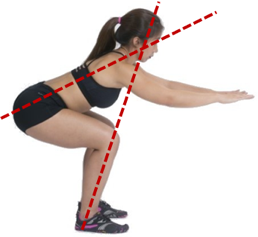
- Research by Fry, et al., (2003) examined squats where knees moved, or were restricted from moving forward. As expected, with forward knee restriction, shear forces and torques at the knee were reduced.
- Shear forces at knee involve anterior-posterior movement of bones at joint – affects cruciate ligaments most notably.
- ACL anterior shear forces start around a 15° knee bend, experience greatest shear forces around 30°, which then diminish after 60° knee bend.
- PCL posterior shear forces start around a 30° knee bend, experience greatest shear forces around 60°, which then diminish after 90° knee bend (not same as thighs parallel to floor).
- Squatting beyond 90° knee bend alters compressive forces within knee – passive structures around joint (e.g., joint capsule) assume much of these forces, which unloads cruciate ligaments in most people and can potentially decrease compression forces on the menisci and articular cartilage in the joint.
- However, restricting forward knee movement = greater shear forces and torque at hips v. squatting with knees moving forward. Ramifications are more serious given how the lumbar spine is more susceptible to injury. In other words, more forward leaning at the hips due to forward knee restriction = greater shear forces between individual spinal vertebrae (e.g., L5-S1, L5-L4, L4-L3, etc.) and greater risk of back injury. As hips drive forward, spine extends backwards during rising phase. Translated – greater lumber extension is problematic – for every 2° of spinal extension from neutral, compressive forces on the posterior annulus (disc portion resists pressure during compression) of each disc increases by an average of 16%.
Given the need to spare the low back, the squat should be initiated by first driving the hips backwards (hinging) which:
- Helps eccentrically load the gluteus maximus
- Helps initiate an isometric contraction within hamstrings that help unload the ACL.
The knee only begins to translate forward at about 15 – 30° of hip flexion, creating more of a hinge joint at the knee which may reduce potential shear forces.
- Keep Knee Aligned over 2nd and/or 3rd Toes
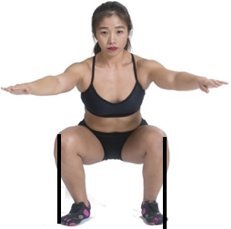
- The talocrural joint between the fibula, tibia and talus are more involved in plantar flexion and extension (i.e., mobility) whereas the talocalcaneal joint between the talus and calcaneus is more involved in postural stability, controlling/resisting inversion/eversion and pronation/supination. However, when the talocrural joint lacks mobility, the talocalcaneal joint contributes, thereby compromising its stability by pronating and everting. This is witnessed by inside of feet collapsing as one lowers into the squat which also drives the knees inwards, increasing stress lines along the ACL. This is perhaps the biggest issue in the squat – limited ankle mobility. Suggestion – remove your shoes to squat – assess whether the feet collapse inwards as the body is lowered.
- Be sure not to confuse slight foot eversion of 8-10° in standing position with a neutral talocalcaneal position with what might appear to be eversion and pronation. Normal foot position is generally considered to be feet parallel to 8-10° of eversion.
- Opening / Widening your Stance
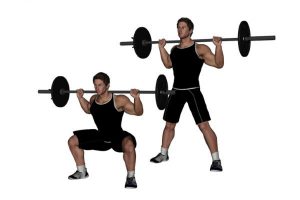
- A wide squat-stance is one where the feet are generally placed between 150 – 200 % of shoulder width. This generally allows one to squat deeper – deep squats are popular given how they, coupled with a rack position that is a little lower on the back, can effectively target the gluteus maximus, adductors (muscles on inside of thigh) and hamstrings.
- By contrast, a narrow squat-stance is generally considered to be one where the feet are no wider than 120 % of shoulder width. This, coupled with higher bar rack position, loads more into the anterior muscles like your quads. This position however does increase the potential for more forward knee movement
- Back to the wide stance – some opt to rotation the legs and feet outward and this is generally acceptable if the rotation occurs at the hip joint (i.e., femoral head), and not at the knee. The more one rotates outward (i.e., 15 – 30° outward rotation), the greater the engagement from the adductors and the belief that the more powerful the squat becomes, but this position should never compromise good form. In other words, any limitations in adductor extensibility will become an issue during the deep phase and cause valgus knee collapse (inward knee collapse). So, always maintain the knee alignment over the 2nd
- Furthermore, excessive external femoral rotation (i.e., beyond 30 – 40°) might also change hip position – to accommodate external rotation of the femur, the pelvis tilts anteriorly which changes lumbar spine alignment (increasing low back stress) and may even alter the body’s center of mass leading to a loss of balance and stability. FYI – when un-racking a bar, the pelvis naturally shifts slightly forward and rotates posteriorly (image water falling out a back of a bucket = posterior rotation) – this re-establishes balance as the bar is positioned slightly behind our natural line of gravity. What this means is a wide stance may require an anterior pelvic tilt = potential loss of balance and stability which can be a concern when lifting heavy. To experience this pelvic position change, stand and externally rotate your thighs – notice the tension build up in your low back as you continue rotating outwards.
- Maintain the Head-up Position
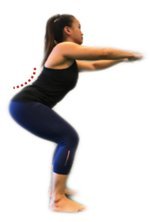
- The head-up position is another common due heard with squatting. On one side, a head down position by as little as 4½° from neutral can increase spinal flexibility, which in turn increases posterior spinal compression. Furthermore, it can also diminish balance.
- By contrast, a head-up position is believed to help maintain balance and shift weight into the heels. More often than not, this is usually a consequence of inadequate hip flexor and/or ankle mobility that creates the forward trunk lean that necessitates a head-up position. Unfortunately in many, this position extends the thoracic spine, which in turn may hyperextend the lumbar spine and increase those compressive forces.
- Good cueing is maintenance of a rigid spine that is either neutral or slightly flattened. This can easily be taught using a dowel and aiming to keep constant contact with it at sacrum, thoracic spine and back of the head throughout the squat movement.
- A slightly flattened spine is quite normal during squats, especially with increased loads. Remember, as the bar is placed behind the line of gravity of the body, the hips naturally move slightly forward (= posterior tilt) to maintain center of gravity when the bar is un-racked – this flattens the lumbar spine slightly.
- What needs to be done….? (a) Allow the tibia to translate forward = ankle mobility with some possible hip flexor mobility + core stability, (b) then reposition spine to be parallel with the tibia (i.e., parallel lines) and (c) the head can fall into a more neutral position, but keep the eyes looking forward for balance.
- Key Point – Engage your core and abdominal musculature during the squat as this helps prevent lumbar hyperextension so frequently observed. Guess what? This can result in more core/ab muscle engagement than witnessed during a plank exercise – yes, your squats do targets your core and abs very effectively.
While some may argue that the squat is perhaps one of the most functional exercises we can do – that statement is not without controversy. While it does mimic a bend-and-lift movement, in life, that movement to pick up a box or child requires the hands to reach towards the floor and not be positioned with shoulder abduction and external rotation as in a back squat. Therefore, the traditional deadlift movement is the truly functional movement and should be taught first as a pre-requisite to the squat. Moving the arms into the back squat position requires thoracic extension that some may not have. The squat therefore, will compromise lumbar stability as the individual attempts to move the arms into that position. Qualify for the squat with a movement screen (i.e., moving the arms into the back squat position while observing lumbar stability) before attempting/ teaching the exercise. A movement should always precede an exercise.
Also, the depth of your squat should be dictated by a movement need (i.e., to get your fingers to the ground under a box) and not by an exercise (i.e., thighs parallel to the ground).
Although many variation of the squat exist, some truths will always prevail – maintain your knee/foot alignment, ensure hinging and timing of forward knee translation, facilitate adequate ankle mobility to avoid dysfunction, maintain a rigid pelvis (sacrum, thoracic spine and head) and aim to achieve parallel alignment between your tibia and trunk. With proper form, the likelihood of a repetitive-type injury reduces and performance improves.
References:
- Abelbeck KG, (2002). Biomechanical model and evaluation of a linear motion squat type exercise. Journal of Strength and Conditioning Research, 16:516-524.
- Caterisano A, Moss RF, Pellinger TK, Woodruff K, Lewis VC, Booth W, and Khadra T, (2002). The effect of back squat depth on the EMG activity of 4 superficial hip and thigh muscles. Journal of Strength and Conditioning Research; 16(3):428 – 432.
- Cook G and Jones B, (2007). Secrets of the Hip and Knee. www.functionalmovement.com
- Escamilla RF, (2001). Knee biomechanics of the dynamic squat exercise. Medicine and Science in Sports and Exercise, 33:127 – 141.
- Fry AC, Smith JC and Schilling BK, (2003). Effect of knee position on hip and knees torques during the barbell squat. Journal of Strength and Conditioning Research, 17:629-633.
- Kanamori A, Woo SL, Ma CB, Zeminski J, Rudy TW, Li G, and Livesay GA (2000). The forces in the anterior cruciate ligament and knee kinematics during a simulated pivot shift test: A human cadaveric study using robotic technology. Arthroscopy, 16(6):633 – 639.
- Li G, Rudy TW, Sakane M, Kanamori A, Ma CB, and Woo SL (1999). The importance of quadriceps and hamstring muscle loading on knee kinematics and in-situ forces in the ACL. Journal of Biomechanics, 32(4):395 – 400.
- Markolf KL, Slauterbeck JL, Armstrong KL, Shapiro MM, and Finerman GA (1996). Effects of combined knee loadings on posterior cruciate ligament force generation. Journal of Orthopaedic Research, 14(4):633 – 638.
- Sakane M, Fox RJ, Woo SL, Livesay GA, Li G, and Fu FH, (1997). In situ forces in the anterior cruciate ligament and its bundles in response to anterior tibial loads. Journal of Orthopaedic Research, 15(2):285 – 293.
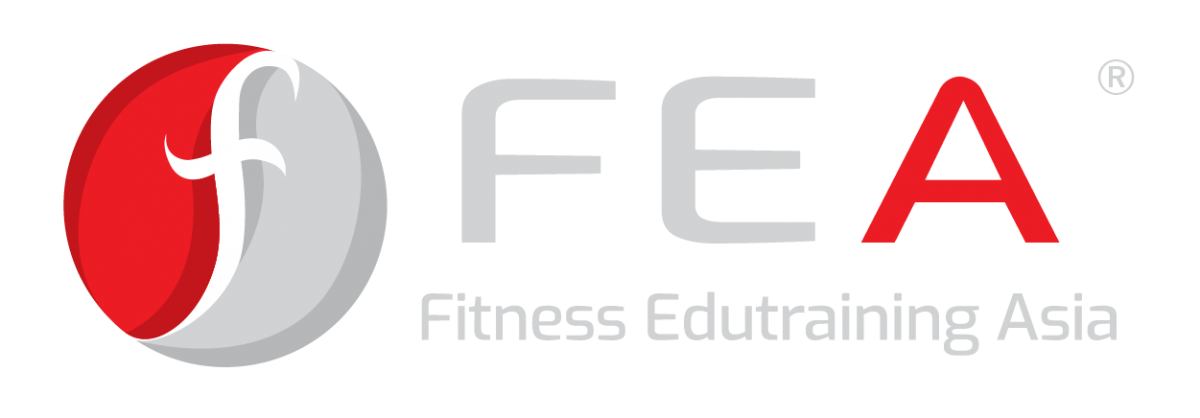
Featured Videos
Featured Industry Insights Videos
Mentor Corner #4: Are All PT Certifications Created Equally?
Exercise Techniques Featured Videos
BENT OVER ROW: Here’s how to do it.
Biomechanics Exercise Sciences Featured Videos
Kinesiological Concepts: Force Couples #1
Articles Featured
? ????? ?? ??????? ??? ?????? ?????-?? ????????/ ? ??????? ??? ?????? ???????? ?????-??/ ? 个步骤: ?????-?? 疫情期间 心肺复苏术( ???)
Articles Featured
The Latest Scoop – Protein Supplementation and Things to Know (Published date: 22 Jan 2018)
Articles Featured
職涯發展